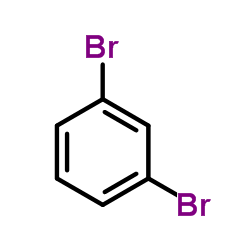The disposition and metabolism of 1,3-dibromobenzene in the rat.
A Sapota, J A Szymańska, B Czerski, J K Piotrowski
Index: Chemosphere 39(13) , 2229-38, (1999)
Full Text: HTML
Abstract
The distribution, excretion and metabolism of 1,3-dibromobenzene following a single i.p. administration to rats 100 or 300 mg/kg was investigated using radiotracer [3H] and GC-MS technique. After 72 hours about 74 to 90% were excreted in urine. The highest radioactivity was observed in the liver, kidneys and fat tissue. Later on a steady decline of radioactivity was apparent in all investigated tissues except for blood cells and the sciatic nerve, where constant levels were noted. In urine the following substances were identified and quantified by GC peak areas: unchanged 1,3-DBB (18%), dibromophenols (34%), dibromothiophenols (28%), dibromothioanisole (1.8%), bromophenol (5.5%), bromohydroxythiophenols (5%), and bromohydroxythioanisole (7.5%).
Related Compounds
| Structure | Name/CAS No. | Molecular Formula | Articles |
|---|---|---|---|
 |
1,3-Dibromobenzene
CAS:108-36-1 |
C6H4Br2 |
|
Hepatotoxicity of brominated benzenes: relationship between ...
1998-01-01 [Arch. Toxicol. 72(2) , 97-103, (1998)] |
|
Comparison of hepatotoxicity of 1,2-, 1,3- and 1,4-dibromobe...
1996-01-01 [J. Appl. Toxicol. 16(1) , 35-41, (1996)] |
|
Microwave-assisted Suzuki coupling on a KF-alumina surface: ...
[Tetrahedron Lett. 44(19) , 3817-20, (2003)] |
|
Synthesis of [n]- and [n.n]cyclophanes by using Suzuki-Miyau...
2002-07-26 [J. Org. Chem. 67(15) , 5333-7, (2002)] |
|
Biochemical alterations as measures of acute and subacute he...
1996-01-01 [Arch. Toxicol. 71(1-2) , 99-106, (1996)] |